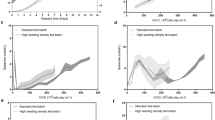Abstract
Fed-batch cultivations of hybridoma cell cultures for antibody production were computer simulated by a detailed structured model, that divides the cell mass into four metabolic compartments and makes use of descriptions of the most important metabolic pathways. Surprisingly the simulations indicate, that online or frequent off-line control of fed-batch hybridoma cultures may lead to low and variable yields of antibody product. With less frequently controlled fed-batch cultures the system is more stable; and there is an optimal time interval for control, that depends on the feeds selected. The product yields in optimal fed-batch cultivations, however, are seldom higher than in comparable batch cultivations.
Similar content being viewed by others
References
Wagner, R.; Ryll, T.; Krafft, H.; Lehmann, J.: Variation of amino acid concentrations in the medium of HU β-IFN and HU IL-2 producing cell lines. Cytotechnology 1 (1988) 145–150
Schmid, G.; Johannsen, R.: Metabolic quotients for recombinant CHO and BHK cell lines producing human antithrombin III. Biotech. Lett. 12 (1990) 317–322
Glacken, M. W.; Huang, C.; Sinskey, A. J.: Mathematical descriptions of hybridoma culture kinetics. III. Simulation of fedbatch bioreactors. J. Biotechnol. 10 (1989) 39–66
Suzuki, E.; Ollis, D. F.: Enhanced antibody production at slowed growth rates: Experimental demonstration and a simple structured model. Biotechnol. Prog. 6 (1990) 231–236
de Tremblay, M.; Perrier, M.; Chavarie, C.; Archambault, J.: Optimization of fed-batch culture of hybridoma cells using dynamic programming: Single and multi feed cases. Bioprocess Eng. 7 (1992) 229–234
Batt, B. C.; Kompala, D. S.: A structured kinetic modeling framework for the dynamics of hybridoma growth and monoclonal antibody production in continuous suspension cultures. Biotechnol. Bioeng. 34 (1989) 515–531
Box, G. E. P.; Hunter, W. G.; Hunter, J. S.: Statistics for experimenters. An introduction to design, data analysis, and model building. New York, John Wiley & Sons 1978
Boraston, R.; Thompson, P. W.; Garland, S.; Birch, J. R.: Growth and oxygen requirements of antibody producing mouse hybridoma cells in suspension culture. Develop. Biol. Standard 55 (1984) 103–111
Al-Rubeai, M.; Chalder, S.; Bird, R.; Emery, A. N.: Cell cycle, cell size and mitochondrial activity of hybridoma cells during batch cultivation. Cytotechnology 7 (1991) 179–186
Strudsholm, K.; Damgaard, J.; Emborg, C.: Application of statistical experimental designs in computer simulations of runaway fermentations. Bioprocess Eng. 8 (1992) 113–119
Miller, W. M.; Blanch, H. W.; Wilke, C. R.: A kinetic analysis of hybridoma growth and metabolism in batch and continuous suspension culture: Effect of nutrient concentration, dilution rate, and pH. Biotechnol. Bioeng. 32 (1988) 947–965
Buell, D. N.; Fahey, J. L.: Limited periods of gene expression in immunoglobulin-synthesizing cells. Science 164 (1969) 1524–1525
Byars, N.; Kidson, C.: Programmed synthesis and export of immunoglobulin by synchronized myeloma cells. Nature 226 (1970) 648–650
Ramirez, O. T.; Mutharasan, R.: Cell cycle- and growth phasedependent variations in size distribution, antibody productivity, and oxygen demand in hybridoma cultures. Biotechnol. Bioeng. 36 (1990) 839–848
Ray, N. G.; Karkare, S. B.; Runstadler, P. W., Jr.: Cultivation of hybridoma cells in continuous cultures: Kinetics of growth and product formation. Biotechnol. Bioeng. 33 (1989) 724–730
Phillips, P. J.; Marquis, C. P.; Barford, J. P.; Harbour, C.: An analysis of some batch and continuous kinetic data of specific monoclonal antibody production from hybridomas. Cytotechnology 6 (1991) 189–195
Jo, E.-C.; Park, H.-J; Park, J.-M.; Kim, K.-H.: Balanced nutrient fortification enables high-density hybridoma cell culture in batch culture. Biotechnol. Bioeng. 36 (1990) 717–722
Reuveny, S.; Velez, D.; Macmillan, J. D.; Miller, L.: Factors affecting cell growth and monoclonal antibody production in stirred reactors. J. Immunol. Meth. 86 (1986) 53–59
Luan, Y. T.; Mutharasan, R.; Magee, W. E.: Effect of various glucose/glutamine ratios on hybridoma growth, viability and monoclonal antibody formation. Biotech. Lett. 9 (1987) 535–538
Griffiths, J. B.: Animal cell culture processes — batch or continuous? J. Biotechnol. 22 (1992) 21–30
Ozturk, S. S.; Palsson, B. O.: Chemical decomposition of glutamine in cell culture media: Effect of media type, pH, and serum concentration. Biotechnol. Prog. 6 (1990) 121–128
Ozturk, S. S.; Riley, M. R.; Palsson, B. O.: Effects of ammonia and lactate on hybridoma growth, metabolism, and antibody production. Biotechnol. Bioeng. 39 (1992) 418–431
Author information
Authors and Affiliations
Rights and permissions
About this article
Cite this article
Hansen, H.A., Madsen, N.M. & Emborg, C. An evaluation of fed-batch cultivation methods for mammalian cells based on model simulations. Bioprocess Engineering 9, 205–213 (1993). https://doi.org/10.1007/BF00369404
Received:
Issue Date:
DOI: https://doi.org/10.1007/BF00369404




